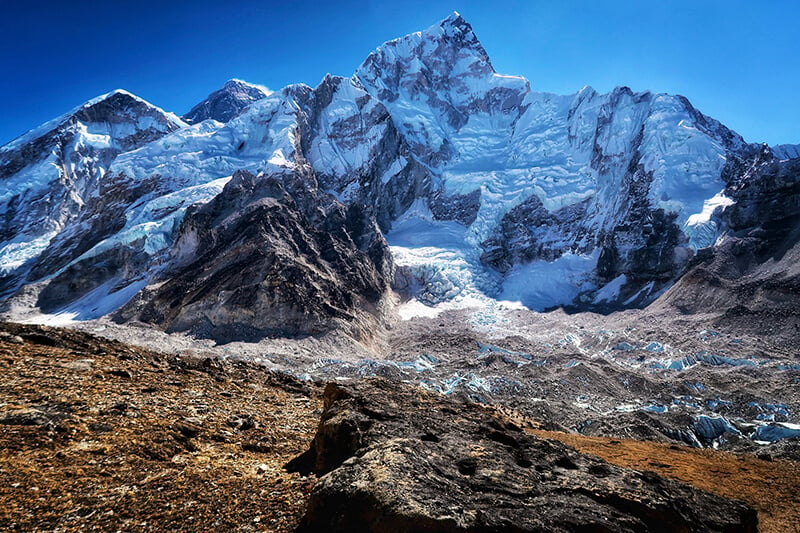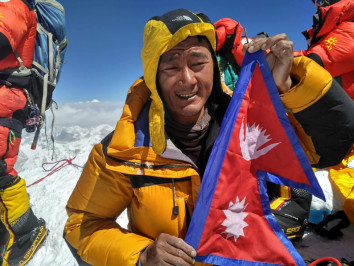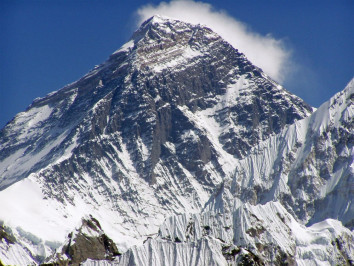What Is the 8–3 Rule on Everest? A Complete Guide for Climbers (2025 Update)

 Kedar Neupane
18th Nov, 2025
Kedar Neupane
18th Nov, 2025
Kedar Neupane
I am Kedar Neupane, a passionate traveler, entrepreneur, mentor, and social contributor, born and raised in a village near the Nepal-China border in Sindhupalchok, Nepal. With a Master’s degree in Business from Tribhuvan University and Level 2 proficiency in the German language, I have dedicated my life to tourism, trade, mentorship, and holistic well-being.
🌍 A Global Explorer with a Vision
Having explored 26+ countries, I have gained profound insights into diverse cultures, business landscapes, and global tourism. My travels have taken me to:
🇹🇭 Thailand | 🇧🇹 Bhutan | 🇲🇾 Malaysia | 🇸🇬 Singapore | 🇨🇳 China | 🇭🇰 Hong Kong | 🇩🇪 Germany | 🇵🇱 Poland | 🇦🇹 Austria | 🇨🇭 Switzerland | 🇭🇺 Hungary | 🇳🇱 Netherlands | 🇧🇪 Belgium | 🇫🇷 France | 🇦🇪 UAE | 🇬🇧 UK | 🇺🇸 USA | 🇹🇷 Turkey | 🇶🇦 Qatar | 🇮🇳 India | 🇮🇩 Indonesia | 🇨🇦 Canada
Through my journeys, I have developed a deep appreciation for cultural exchange, adventure tourism, and sustainable business practices.
🏔️ Entrepreneurial & Professional Journey
I am actively involved in tourism, trade, and mentorship, leading multiple ventures that promote sustainable travel, adventure tourism, and business development:
✔ Founder & MD – Actual Adventure Pvt. Ltd. (A leading adventure travel company in Nepal)
✔ CEO – Himalayas Destination Management Company (Creating premium travel experiences)
✔ MD – Nepal Export & Import Pvt. Ltd. (Promoting Nepalese products globally)
✔ MD – Actual Mentor Pvt. Ltd. (Empowering entrepreneurs and professionals)
✔ Chairman – World Expedition Nepal (Focusing on high-altitude expeditions and trekking)
Through my entrepreneurial journey, social contributions, global explorations, and commitment to lifelong learning, I strive to inspire others to pursue their passions while making a meaningful difference. My dream is to build a world where travel, business, and holistic well-being come together, fostering growth, sustainability, and happiness for all.
Everything you need to know about the Everest 8–3 rule, summit safety, oxygen strategy, and why this guideline matters in the Death Zone. The Everest 8–3 rule is one of the most important safety guidelines used by leading expedition operators to protect climbers in the Death Zone—the dangerous region above 8,000 meters, where oxygen levels drop to less than one-third of sea level and the human body begins to rapidly deteriorate. The rule simply states that climbers should reach 8,000 meters by 8:00 AM and the summit by 11:00 AM (3 hours later). This timing is not arbitrary; it is based on decades of high-altitude observation, weather patterns, and rescue data. Reaching the Balcony (around 8,350 m) or South Col route checkpoints early ensures that climbers have enough daylight, energy, and supplemental oxygen to complete the ascent and descend safely before afternoon winds rise. After 11 AM, the summit ridge often becomes unstable with rapidly increasing wind speeds, blowing snow, and falling temperatures. The risk of frostbite, disorientation, and exhaustion increases dramatically as oxygen bottles run low. Climbers who miss the 8–3 timing are more likely to run out of oxygen on descent, experience hypoxia-induced confusion, and become stuck in traffic jams near the Hillary Step—a combination that has contributed to many fatalities on Everest. The rule also ensures a safe buffer for emergencies, allowing guides to respond if a climber’s regulator freezes, an oxygen bottle malfunctions, or a weather shift occurs. Ultimately, the 8–3 rule is about protecting climbers from the extreme risks of the Death Zone, ensuring they avoid the most dangerous time of day on the upper mountain, maintain enough supplemental oxygen for a full descent to Camp 4, and return to safety before conditions deteriorate. Even experienced Sherpas follow this timing strictly because the mountain becomes exponentially more lethal after midday. The rule is not about climbing speed—it is about decision-making, oxygen management, and survival. Operators who enforce the 8–3 guideline have significantly fewer accidents, which is why reputable companies treating Everest responsibly consider it a non-negotiable part of summit strategy.
Table of Contents
Everest 8–3 Rule Explained: Everything You Need to Know About Summit Safety and Oxygen Use in the Death Zone
Mount Everest (8,848.86 m) is the highest mountain on Earth, and every year hundreds of climbers attempt to reach its iconic summit. But at extreme altitude—especially above 8,000 meters, known as the Death Zone—tiny mistakes can be deadly. To reduce risk during the Everest summit push, guides and expedition leaders follow an important principle known as the 8–3 Rule.
Definition: What Is the 8–3 Rule on Everest?
The 8–3 Rule on Mount Everest is a safety guideline that states:
1. You should reach the summit before 8:00 AM.
2. You must return back to Camp 4 (South Col) by around 3:00 PM.
This rule helps climbers avoid the afternoon jet-stream winds, rapidly worsening weather, oxygen depletion, and long exposure in the Death Zone.
It is widely used by experienced Everest guides, IFMGA Sherpas, and top expedition companies to reduce accidents and improve summit success rates.
Why Does the 8–3 Rule Exist?
Climbing Everest involves crossing dangerous terrain like the South Col, Balcony, South Summit, Cornice Traverse, and the Hillary Step. These sections require perfect weather and maximum physical strength.
Here’s why the Everest 8–3 rule is so important:
1. Avoiding Afternoon Jet Stream Winds
Every day on Everest, winds become extremely strong after 11 AM. Afternoon gusts often reach 70–120 km/h, strong enough to knock climbers off ridges. Summiting before 8 AM ensures:
-
Calmer conditions
-
Less wind chill
-
Less risk at exposed sections like the Hillary Step
2. Limited Supply of Oxygen Bottles
Climbers generally carry 2–3 bottles of supplemental oxygen during the summit push. Delays cause:
-
Oxygen shortage
-
Frostbite
-
Cerebral edema (HACE)
-
Pulmonary edema (HAPE)
Following the 8–3 rule ensures oxygen lasts for the ascent and descent.
3. Weather Becomes Unpredictable After Midday
Even on a perfect forecast, Everest weather can suddenly change. Afternoon storms can bring:
-
Whiteout
-
Zero visibility
-
Temperature drops
-
High avalanche risk
Returning to Camp 4 by 3 PM keeps climbers safe.
4. Avoiding Traffic Jams on the Route
Everest’s summit ridge is extremely narrow. Traffic jams increase time spent in the Death Zone. Climbing early avoids:
-
Crowds
-
Slow teams
-
Long waits at fixed ropes
-
Dangerous exposure
5. Preventing Night Descents
Descending in the dark at 8,000+ meters increases fatalities. Climbers can slip at:
-
The Balcony
-
Lhotse Face
-
Hillary Step
-
South Summit Ridge
By reaching Camp 4 by 3 PM, climbers return during daylight.
How the 8–3 Rule Fits into an Everest Summit Push Timeline
A typical summit night from the South Col looks like this:
| Time | Location | Description |
|---|---|---|
| 8–10 PM (previous night) | Leave Camp 4 (7,900 m) | Start summit push |
| Midnight–2 AM | Balcony (8,400 m) | First oxygen change |
| 3–5 AM | South Summit (8,750 m) | Critical decision point |
| 5–8 AM | Summit (8,848 m) | Must reach BEFORE 8 AM |
| 8–10 AM | Descend to South Summit | Avoid traffic jams on descent |
| 12–1 PM | Balcony | Oxygen bottle change |
| 2–3 PM | Arrive Camp 4 (South Col) | MUST return by 3 PM |
This timeline forms the foundation of the 8–3 rule.
Why Many Climbers Fail If They Do NOT Follow the 8–3 Rule
Ignoring this rule causes most common Everest tragedies. Failure happens due to:
-
Leaving Camp 4 too late
-
Moving too slowly
-
Long traffic jams
-
No spare oxygen
-
Overconfidence
-
Ignoring guide instructions
Most Everest deaths occur during descent, not during ascent. The 8–3 rule significantly reduces this risk.
Who Created the Everest 8–3 Rule?
It is not an official government rule but a widely accepted guideline used by:
-
IFMGA mountain guides
-
Experienced Sherpa climbers
-
Premium Everest expedition companies
It has been adapted from decades of mountaineering lessons to maximize safety.
Where the 8–3 Rule Is Applied
This rule is mainly used on the South Col Route (Nepal side), the most popular and safest Everest climbing route.
Key points where the rule matters:
-
South Col / Camp 4 (7,900m)
-
Balcony (8,400m)
-
South Summit (8,750m)
-
Hillary Step (8,790m)
-
Summit (8,848m)
Is the 8–3 Rule Strict?
Most professional guides follow it strictly. Some elite climbers may adjust it slightly, but for commercial climbers, the rule is essential.
If a climber is too slow, guides often turn them around at:
-
The Balcony
-
The South Summit
-
The Hillary Step
This is for safety and oxygen management.
Is the 8–3 Rule Used on the Tibet/North Side?
Yes, but timings may differ slightly. On the North Ridge Route, the rule is often:
-
Summit before 9 AM
-
Return to Camp 3 by 4 PM
The principle remains the same.
Everest 8–3 rule, Everest climbing rules, Everest summit timing, Everest summit push strategy, Everest oxygen use, Everest death zone safety, Mount Everest summit window, best time to summit Everest, Everest South Col route, Everest Hillary Step, Everest Balcony, Everest Base Camp to summit, how to climb Everest safely, Everest climbing guide, Everest 2025 update, Everest summit decision point.
Conclusion: The 8–3 Rule Saves Lives on Everest
Climbing Everest is one of the most dangerous adventures on Earth. The 8–3 rule—summit before 8 AM and return to Camp 4 by 3 PM—is a simple but powerful safety guideline that keeps climbers alive in the Death Zone.
It helps manage:
-
Oxygen supply
-
Weather risk
-
Traffic jams
-
Fatigue
-
Summit timing
If you’re preparing for the Everest Expedition 2026 or 2027, understanding and following this rule is essential for a safe and successful climb.
Recent Posts

19th Nov, 2025

19th Nov, 2025

27th Oct, 2025

28th Aug, 2025





.jpeg)










